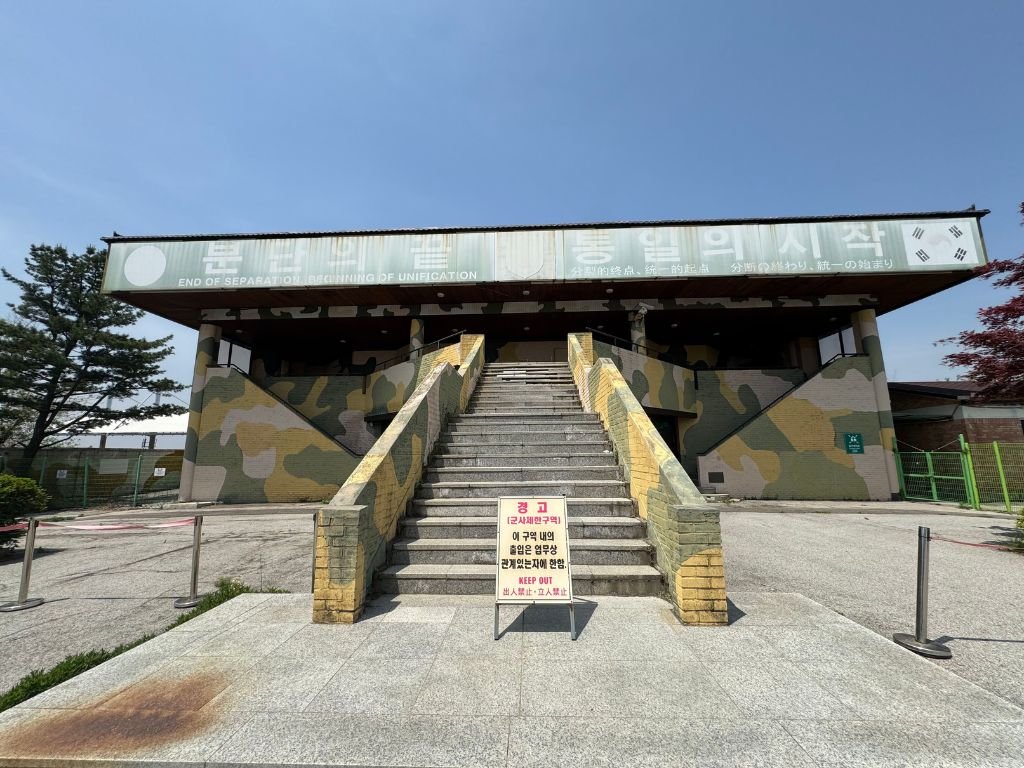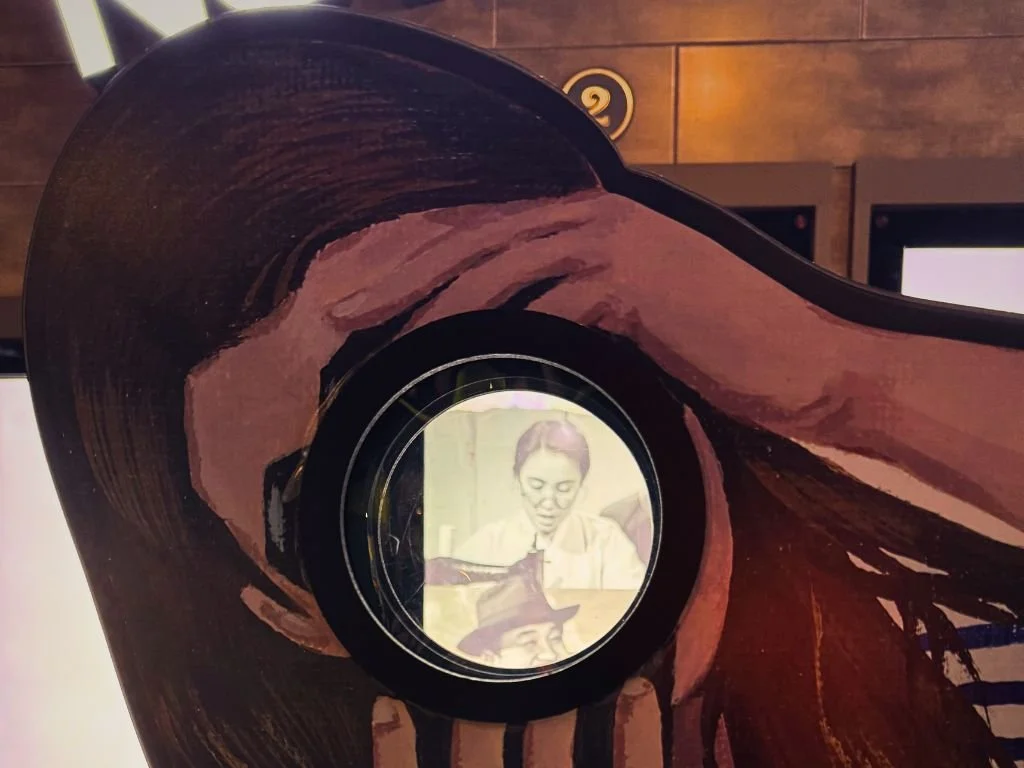The road to the DMZ: what to expect on a half-day tour from Seoul
Visiting the DMZ from Seoul? Here's what we found on a half-day tour, from standing 170m away from the North Korean border to sipping DMZ-branded beer in Unification Village.
While the Korean War ended in 1953 with an armistice, not a peace treaty, the two Koreas remain technically at war. Having grown up on eleven seasons of M*A*S*H, a visit to the DMZ, or Demilitarized Zone, was firmly at the top of our must-see list during our recent trip to Seoul.
A jaunt through a heavily militarised buffer zone between hostile nations doesn’t sound like your typical holiday activity. Yet in the 21st century, that’s exactly what it is: a surreal blend of tourism, history, and tension, wrapped in souvenirs and razor wire.
With the equally otherworldly experience of Korean baseball waiting for us that evening, we opted for the half-day tour—enough time to discover Imjingak Park, the Bridge of Freedom, the Third Tunnel of Aggression, weaponised K-pop, a surprise vegan ice cream, and at least one very on-brand can of DMZ beer.
Booking a DMZ tour from Seoul
To paraphrase The Lord of the Rings: one does not simply walk into the DMZ. While the zone lies just 30 to 50 miles (or 50 to 60 kilometres) north of Seoul—around a 45-minute drive from Myeongdong on a good day—visiting by yourself is not allowed. Entry is strictly controlled and only permitted through a registered tour operator.
We booked via GetYourGuide, though other platforms like Klook and Viator also offer similar packages. Our actual tour (this one here, if you'd like to follow in our footsteps) was operated by PLK Travel. Shoutout to Cindy, an amazing host for the day.
There’s a full-day version that includes a very impressive-looking suspension bridge, but with evening plans already in place, and only limited time in Seoul, we opted for the half-day tour. After meeting Cindy and the rest of the group at Myeongdong Station at 6:50am on a thankfully clear day, we set off north. Our first stop was Imjingak Park, where the tour proper began.
We’d be back in the city just after lunchtime, but it’s fair to say our perspective had shifted a little by then.
What you’ll see on the tour
So, what does a tour through a wartime buffer actually look like? For starters, there’s no mistaking where you are. From the moment you cross into the zone, the landscape changes: razor wire fences coil along the roads, fresh-faced and impossibly young soldiers are everywhere, and you’ll pass through multiple military checkpoints.
It is absolutely essential to bring your passport—it's checked both on the way in and out. Having a soldier inspect our documents wasn't exactly on our travel Dream List, but hey, it’s officially been ticked off now.
Unless you take the optional full-day tour that includes the suspension bridge, there are four main stops along the way.
Imjingak Park & Bridge of Freedom
When we first arrived at the tour stop bus parking lot at Imjingak Park, I must confess I thought, “Is this it?” A shopping mall? A souvenir shop? Wrong. This place is a memorial site—a symbolic gateway to history. Built to honour those separated by the Korean War, it offers a quiet space for reflection just steps from the border.
Against the deceptively peaceful riverside backdrop, where rice paddies stretch and an unintentional wildlife sanctuary thrives, a deeper story unfolds. Through ribbons tied to fences, international flags fluttering, and statues both subtle and striking, the weight of history is ever-present.
Stretching across the river is the Bridge of Freedom, both symbol and pathway. Once part of the Gyeongui Railway Line connecting North and South Korea, remnants of train cars linger, reminding visitors of a route that once went both ways—and might one day again.
Third Tunnel of Aggression
This is where things start to get a little surreal. The moment you step off the bus, you’re greeted by giant red, yellow, and blue lettering, an Insta-ready photo spot that also marks the entrance to one of the more chilling sites on the tour. This is the Third Tunnel of Aggression, believed to have been dug by North Korea as part of a planned surprise attack on Seoul. Discovered in 1978 thanks to a defector’s tip, it’s now the centrepiece of the tourist experience.
Before heading underground, we are quickly ushered into a small theatre for a short film about the Korean conflict. Ten minutes of stylised footage that might politely be called a publicity campaign. Some may say propaganda. We’re not here to judge. We watched it seated next to a small group of South Korean and UN soldiers, mostly in their early twenties, our guide told us. “It’s for education,” we were reminded more than once.
Phones, cameras, and most other valuables must be stored in lockers before entering the tunnel. It’s probably for the best. You’ll want to travel light for this physical challenge. Going down is the easy part, though even the descent has an eerie, claustrophobic feel that’s hard to shake. And no, it’s not just the cold air being piped in.
The tunnel stretches 1,635 metres (just over a mile) and gets progressively lower and narrower. My phone’s pedometer was locked away, so I can’t tell you how many steps we took. It felt like plenty. As you reach the end, you'll start to hear irregular clunks and pops as helmets knock against the low rock ceiling. For the final stretch, everyone’s crouching. At the very end, three concrete barriers block further access along the Military Demarcation Line. We were just 170 metres from the North Korean border.
Dora Observatory
A clearer view of the border awaits at the Dora Observatory. From the parking lot, we follow a path flanked by brightly painted walls, each topped with razor wire. It’s a jarring contrast. On the South Korean side, a prominent Christian cross overlooks the border. Beside it, giant speakers blare K-pop relentlessly in the direction of the North. (As of mid-June, new President Lee Jae-myung has now stopped this practice as a gesture of goodwill). As Rebel Heart by girl group IVE echoes across the hills, I briefly wonder what rebellion it might inspire. It’s definitely the most glamorous psychological warfare we’ve seen.
From the Observatory, where photography is strictly verboten, the border quietly stretches before us. On our side, the South Korean flag flutters above fields, military outposts, and overgrown greenery. It’s unexpectedly rural. Across the river, the North’s flag appears just slightly taller. Maybe it’s my imagination. Maybe not.
Through the binoculars, we see the so-called propaganda village, built to showcase an idealised version of life in North Korea. I ask Cindy about the large, boxy buildings in the distance. She explains they’re part of a freight railway line that briefly connected the two countries in the early 2000s. It was destroyed in 2024 when North Korea blew up a section. It hasn’t run since.
Unification Village
The final stop is Paju’s Unification Village or, more specifically, the local shopping centre. The area is known for its Jangdan ginseng, soybeans, and rice, and we were overjoyed to discover a vegan soybean ice cream for sale. Even better, we found a local beer: Pajussal Ale from Daonsoop Brewery, brewed especially for the region. It’s a small but memorable way to end a trip through one of the tensest borders on Earth.
👉 Want more on South Korea’s surprising craft beer scene? Read our full piece on the Seoul ale trail (and beyond) here.
Optional stops (and what we skipped)
Some versions of the tour include a visit to the Gamaksan Suspension Bridge, South Korea’s longest towerless suspension bridge. With its proximity to the DMZ, it promises striking views of the surrounding landscape and a bit more hiking. For us: maybe next time.
Due to time constraints, we chose the shorter tour, which gave us a few extra hours to unwind in Insadong before heading out to a baseball game. We were on holiday, after all.
What to know before you go (Practical tips)
🛂 Passport required
You'll need it to enter and exit the DMZ zone—no exceptions.
👟 Wear comfy shoes
There’s a fair bit of walking across uneven ground.
📐 The Third Tunnel is steep
Especially the climb back up. Be ready for a workout.
👷♀️ Mind your head
The Third Tunnel also gets low and narrow near the end—you’ll be crouching. Helmets are provided.
⛔ Tours may be cancelled last-minute
Military activity can shut things down with little notice.
💵 Bring cash
For snacks and souvenirs (including DMZ beer!). Some places may not accept cards. Be aware that some tours have ‘forced shopping.’ (Ours didn’t).
🛜 Book ahead
Tours often sell out, especially in peak season.
FAQs about visiting the DMZ
-
No, you must book with a licensed tour operator.
-
As close as 170 metres in the Third Tunnel—and even closer through binoculars at Dora Observatory.
-
No. Since July 2023 there are no tours that visit the JSA. At the time of writing, this is still the case. For now, you’ll just have to watch Park Chan-wook’s blockbuster film, JSA (2000).
-
Yes, you better believe it! Anything that can have DMZ printed on it is on offer at every stop. North Korean cash and stamps are available in shops or on the bus.
-
Yes. There were several school age kids on our tour. They will need their own passport. Note: the Third Tunnel is quite steep, but you can skip it. Clean toilets and food are at every stop.
Final thoughts
So, is it worth visiting the DMZ? For the price: absolutely. It’s a striking collision of solemn history, ice cream and, somehow, militarised K-pop.
We came to South Korea for the culture, the food, and the beer scene, but walking a mile (and back) through a tunnel dug for war was a once-in-a-lifetime experience. I don’t think I’ll ever forget the feeling of standing at the observation deck, looking across a border we usually only hear about in news reports or see in documentaries. It’s not your typical holiday destination and maybe that’s exactly why it’s unforgettable.














